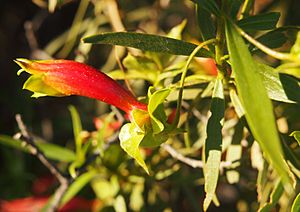Budda facts for kids
Quick facts for kids Budda |
|
|---|---|
 |
|
| Scientific classification | |
| Genus: |
Eremophila (plant)
|
| Species: |
duttonii
|
| Synonyms | |
|
|
Eremophila duttonii, also called budda or harlequin fuchsia bush, is a cool flowering plant. It belongs to the figwort family. This plant grows only in mainland Australia, but not in Victoria. It's usually a shrub or a small tree. It has dark green, sticky leaves. Its unique flowers are red on top and fade to yellow-green below. Scientists have found that parts of this plant can help fight germs.
Contents
What Does Eremophila Duttonii Look Like?
Eremophila duttonii is a shrub or a small tree. It can grow from about 1 m (3 ft) to 3.5 m (10 ft) tall. Its branches feel rough because of old leaf bases. They are also hairy, shiny, and sticky from a natural resin.
The leaves grow one after another along the branches. Sometimes, they are grouped near the ends. They are usually 30–40 mm (1–2 in) long and 3–5 mm (0.1–0.2 in) wide. Their shape is long and narrow, like a spear, and they are sticky.
The Flowers
The flowers grow one by one where the leaves join the stem. Each flower has a stalk that is 10–20 mm (0.4–0.8 in) long. There are 5 sticky, egg-shaped parts called sepals, about 10–15 mm (0.4–0.6 in) long.
The petals are 25–35 mm (0.98–1.4 in) long. They join together at the bottom to form a tube. The top of this tube is red or orange. It fades to yellowish-green inside and underneath. Sometimes, the whole flower tube is yellow. The tube often has a few short hairs and is sticky on the outside. Four parts called stamens stick out past the end of the tube.
This plant usually flowers from June to September. After flowering, it grows dry, oval-shaped fruits. These fruits have a pointed end and are 7.5–13 mm (0.3–0.5 in) long.
Where Does Eremophila Duttonii Grow?
You can find Eremophila duttonii in many parts of mainland Australia. Its most western home is the Warburton area in Western Australia. It also grows in the southern Northern Territory, South Australia, southwestern Queensland, and western New South Wales. It can be found as far east as Broken Hill. This plant likes to grow in red-brown sandy soils. It thrives on plains and hills.
How People Use Eremophila Duttonii
Traditional Uses by Indigenous People
The Arrernte people, who call this plant aherre-intenhe, have used its leaves for medicine for a long time. They used it to help with skin problems, including those caused by tiny mites. They also used it as a gargle for sore throats. It was even used to help with painful eye and ear issues.
Modern Medical Research
Scientists have studied Eremophila duttonii for its medical potential. One study looked at six types of eremophila plants. E. duttonii showed the strongest ability to fight germs. It was especially good against certain types of bacteria. These bacteria can sometimes be hard to treat with common medicines. Another study found two special compounds in the plant that help it fight germs.
Growing Eremophila Duttonii in Gardens
You don't often see Eremophila duttonii in home gardens. It can be tricky to grow from seeds or cuttings. Gardeners often use a special method called grafting. This means joining a piece of E. duttonii onto the roots of another plant, like a Myoporum species.
This plant grows slowly. It prefers a dry, sunny spot with soil that drains well. It can handle light frosts and is very good at surviving dry periods.


